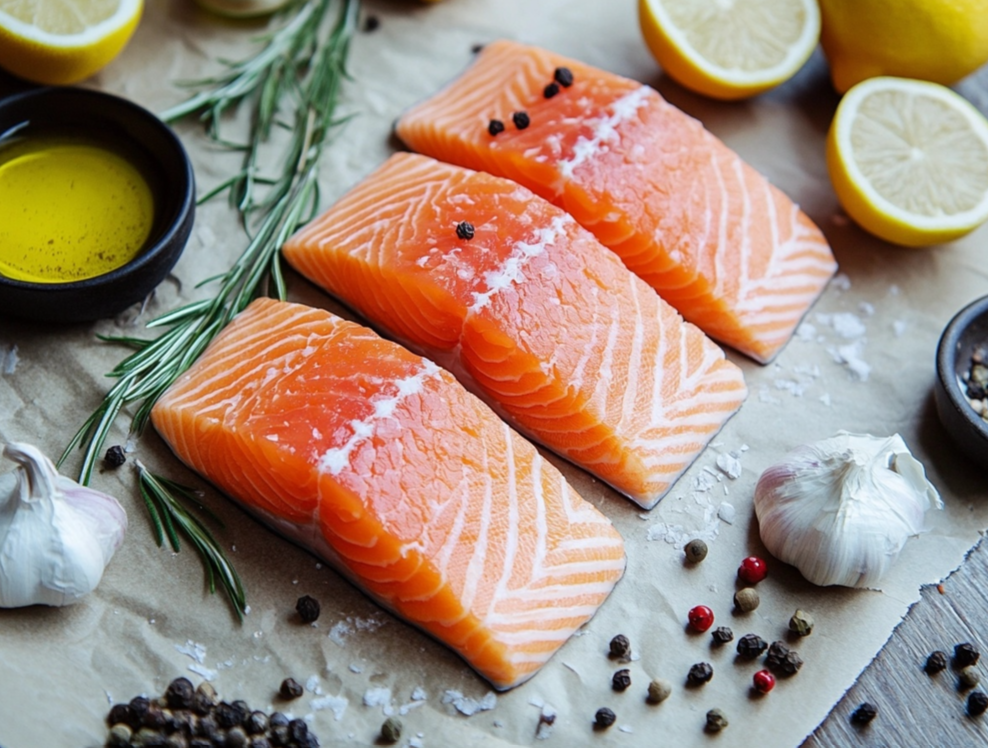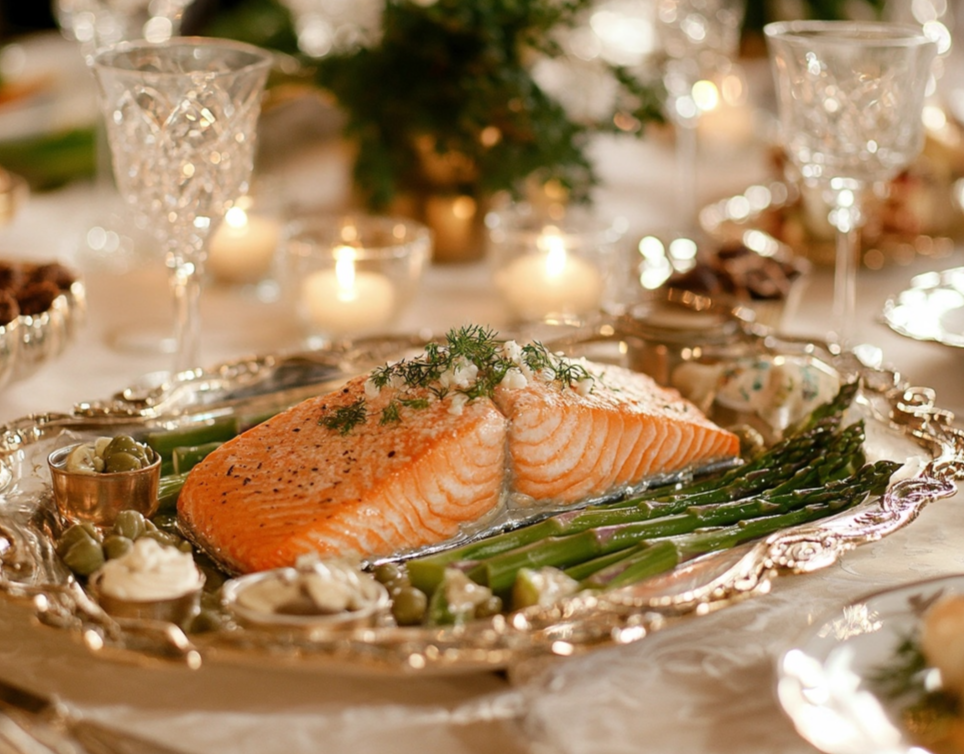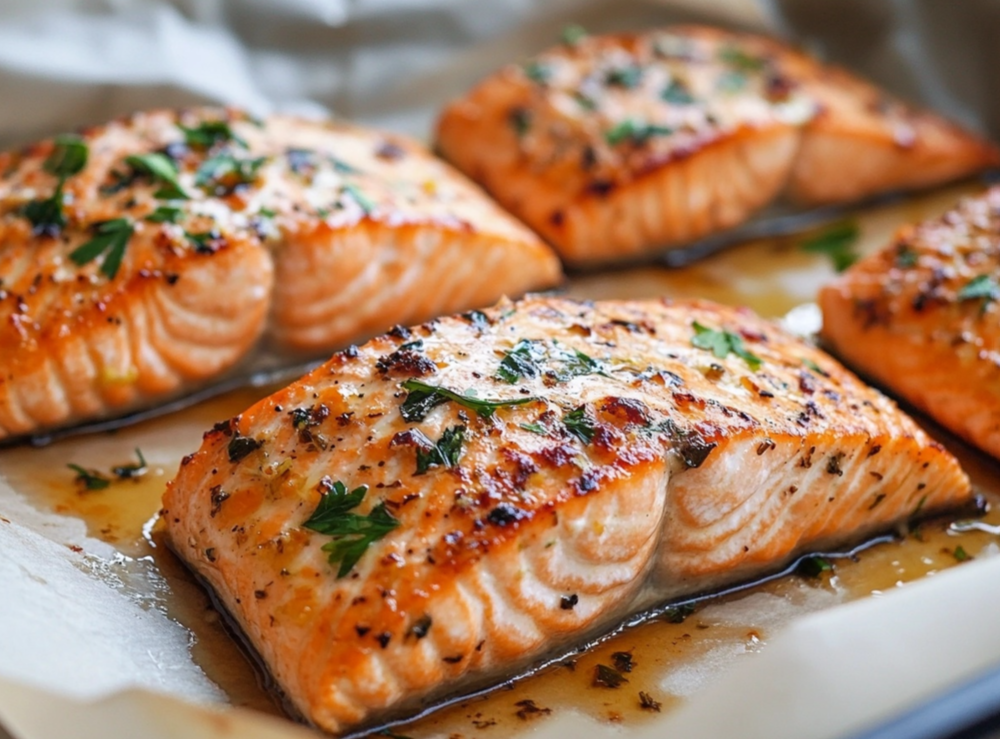Discover how to prepare baked salmon that’s tender, flavorful, and easy enough for any home cook.
Introduction
Baked salmon makes a fast, healthy, and flavorful dinner. This guide shows you every step for oven-roasting this versatile fish to perfection. You’ll learn techniques, seasoning methods, cooking times, and creative serving ideas that will satisfy every palate.
Understanding Baked Salmon Basics
When you choose baked salmon, you invest in a nutritious, protein-packed meal. Indeed, salmon contains heart-healthy fats, vitamins, and minerals. Moreover, it cooks quickly, making it an excellent option for busy weeknights. Additionally, this oven-based approach ensures even cooking and minimal cleanup. Comparatively, other cooking methods, like pan-searing or grilling, require more attention. Conversely, baking lets you set a timer and relax.
Generally, baked salmon turns out tender and moist when prepared correctly. Likewise, it absorbs flavors from seasonings, marinades, and herbs. Therefore, adjusting ingredients to suit your preferences is simple. Eventually, you can create endless variations that please everyone at the table. Basically, once you master the basics, you’ll feel confident experimenting with different glazes, spices, and side dishes.
Key Factors That Influence Perfect Baked Salmon
When striving for perfect baked salmon, consider freshness, thickness, and seasoning. Initially, start with fresh fillets. Consequently, fresher fish leads to better flavor. Equally, the thickness of the fillet affects cooking time. Thicker pieces require more time, whereas thinner cuts finish faster. Therefore, always keep an eye on the fillet’s thickness to prevent overcooking.
Moreover, seasoning plays a huge role. You can use simple salt and pepper or a more complex mixture of herbs, citrus zest, or garlic. Another approach involves marinating or brushing with flavored butter. Comparatively, a citrus-herb marinade differs from a maple-soy glaze. Both yield delicious baked salmon but offer contrasting flavor profiles. Eventually, you’ll learn which combination suits your taste best.
Choosing Quality Salmon
Selecting Fresh Fillets for Baked Salmon
When buying salmon, opt for bright, firm fillets with a pleasant aroma. Accordingly, a fresh piece should have a rich color, either vibrant orange or pink, depending on the variety. Furthermore, the flesh should spring back when gently pressed. If you notice a fishy odor or dull surface, choose another fillet. Essentially, freshness ensures optimal flavor and texture.
Additionally, consider the type of salmon. Wild-caught varieties, like Sockeye or King, boast distinct flavors and textures. Farmed salmon often has a milder taste and more consistent fat content. Indeed, either option can yield excellent results. Nonetheless, knowing the differences lets you pick what aligns best with your culinary goals. Eventually, you’ll find your preferred style of baked salmon.
Prepping the Fillet Before Baked Salmon
Before baking, inspect your fillet for pin bones. Gently run your fingers along the flesh and remove any tiny bones with tweezers. Consequently, this step ensures a more enjoyable eating experience. Additionally, pat the fillet dry with a paper towel. A dry surface helps seasonings adhere better. Moreover, it allows the fish to roast rather than steam.
Afterward, season the fillet generously. Use salt and pepper as a base, then consider adding dried herbs, minced garlic, or lemon zest. Consequently, these choices enhance the natural flavor of baked salmon. Finally, place the seasoned fillet on a lined baking sheet to reduce cleanup. Eventually, this preparation sets the stage for a successful baking process.

Setting the Right Oven Temperature and Time
Ideal Oven Temperature for Baked Salmon
Most chefs recommend baking salmon at around 400°F. Basically, this temperature ensures the salmon cooks evenly without drying out. Generally, it allows the fillets to form a lightly crisp exterior while retaining moisture inside. Consequently, the fish emerges tender and flavorful. Indeed, 400°F strikes a perfect balance between speed and control.
Still, you can adjust the temperature if desired. For example, baking at 375°F takes slightly longer but offers a gentler approach. Conversely, at 425°F, the salmon cooks faster but risks overcooking. Therefore, choose a temperature based on personal preference and thickness of the fish. Eventually, you’ll find your ideal setting for baked salmon.
Timing Your Baked Salmon Perfectly
Timing varies, but a general rule is 10-12 minutes per inch of thickness at 400°F. However, this guideline should be flexible. Factors like oven accuracy and starting fillet temperature can affect cooking time. Therefore, always check doneness a few minutes early. Insert a fork or knife gently into the thickest part to see if it flakes easily.
Additionally, consider using an instant-read thermometer. Ideally, baked salmon reaches an internal temperature of about 125°F to 130°F for medium-rare. Consequently, removing it from the oven at this point ensures it remains moist. Indeed, slightly undercooking and letting the fish rest helps maintain juiciness. Eventually, you’ll master timing through practice and observation.
Flavoring Strategies and Seasoning Blends
Using Citrus, Herbs, and Spices in Baked Salmon
Flavoring your baked salmon can be as simple or complex as you like. Basically, add fresh dill, parsley, or thyme, along with lemon slices, to impart brightness. Consequently, these additions complement salmon’s natural richness. Another way involves rubbing the fillet with olive oil, salt, pepper, and paprika for a subtle smokiness.
Moreover, consider exotic blends like a miso glaze or harissa paste. Comparatively, these bold flavors create a unique taste experience. Equally, a honey and soy sauce marinade adds sweetness and depth. Meanwhile, a mustard-herb crust brings tanginess. Eventually, experimenting with seasonings reveals your favorite profiles for baked salmon.
Marinades and Rubs for Baked Salmon
Marinades infuse salmon with flavor over time. For instance, a mixture of olive oil, soy sauce, garlic, and ginger creates an Asian-inspired taste. Another marinade blends maple syrup, Dijon mustard, and garlic for a sweet-savory glaze. Undoubtedly, marinating requires planning because you must let the fish sit. However, even a short 15-20 minute soak enhances flavor.
Alternatively, dry rubs also work well. For example, combine brown sugar, smoked paprika, and dried basil for a sweet and smoky crust on your baked salmon. Likewise, a zesty rub with dried lemon peel and rosemary imparts a Mediterranean feel. Consequently, marinades and rubs introduce complexity and depth, making your salmon dish stand out.
Sauces and Finishing Touches
After baking, serve your baked salmon with a complementary sauce. Particularly, a creamy dill sauce, yogurt-cucumber dressing, or lemon-butter drizzle adds richness. Additionally, a fresh salsa with mango and avocado brightens the plate. Indeed, these finishing touches let you tailor the meal to your mood or occasion.
Sauces also help balance flavors. For example, a tangy vinaigrette cuts through the salmon’s natural richness. Conversely, a savory mushroom sauce adds earthy depth. Moreover, sauces provide visual appeal, making your dish look gourmet. Eventually, pairing the right sauce with baked salmon ensures a memorable dining experience.
Baking Methods and Techniques
Using Foil or Parchment Paper
Wrapping your baked salmon in foil or parchment paper creates a steamy environment. Consequently, this method, known as en papillote, locks in moisture and aroma. Essentially, the fish steams in its own juices, resulting in a tender texture. Additionally, you can add vegetables, herbs, and a splash of white wine for an all-in-one meal.
However, leaving the salmon uncovered allows the top to caramelize slightly. Accordingly, uncovered baking results in a more roasted flavor. Meanwhile, foil-wrapping emphasizes moistness and tenderness. Indeed, both methods produce delicious outcomes. Therefore, choose based on your preference: foil for succulence or uncovered for a delicate crust.
Using a Baking Dish vs. Baking Sheet
A baking sheet allows heat to circulate evenly around the fillet. Consequently, the salmon cooks uniformly. Moreover, a rimmed sheet prevents juices from spilling. Another option is a baking dish, which collects flavorful juices you can use as a sauce. Comparatively, a baking dish might create a slightly more poached texture.
If you prefer crispy edges, opt for a baking sheet. Conversely, if you want a moist environment, choose a dish and add a small amount of liquid. Thus, the vessel you select influences the final texture of your baked salmon. Eventually, experimenting with different pans helps you discover your ideal method.
Checking Doneness and Resting
To confirm your baked salmon is done, gently press the thickest part with a fork. Subsequently, the flesh should flake but still appear slightly translucent in the center. Another method involves using a thermometer, as mentioned before. Once it reaches about 125°F to 130°F, remove it from the oven.
Afterward, let it rest for a few minutes. Resting lets the fish’s juices redistribute, ensuring a moist bite. Basically, resist the urge to cut into it immediately. Finally, serve with chosen sides, sauces, or garnishes. Eventually, these small steps guarantee that your baked salmon impresses every guest.
Serving Suggestions and Meal Pairings
Classic Side Dishes for Baked Salmon
Choose sides that complement the rich flavor of baked salmon. For instance, roasted asparagus, sautéed spinach, or a vibrant salad enhance the meal. Additionally, grains like quinoa, brown rice, or wild rice add substance. Another great option is a light soup, like a vegetarian tortilla soup as a starter.
Meanwhile, for a brunch setting, serve the salmon alongside avocado toast with feta to add creamy texture. Conversely, for a low-carb approach, pair it with zucchini pasta. Undoubtedly, these sides transform your baked salmon into a complete, balanced meal.
Healthy Accompaniments
Add a bright citrus salad or a crisp cucumber-tomato mix to add freshness. Furthermore, toss together a light vinaigrette to cut through the richness of the fish. Consequently, combining salmon with veggies supports a balanced diet. Essentially, fresh produce and whole grains create a nutritious plate.
Additionally, consider healthy fats, like a drizzle of extra-virgin olive oil or a handful of nuts. These choices boost flavor and provide essential nutrients. Thus, pairing baked salmon with wholesome sides ensures a meal that’s both delicious and nourishing.
Creative Serving Ideas
For special occasions, present the baked salmon whole on a platter with fresh herbs and lemon wedges. Impress guests with a topping of toasted pine nuts or pomegranate seeds. Consequently, these finishing touches add texture and visual appeal.
Alternatively, flake leftover salmon into salads, sandwiches, or pasta dishes. Add it to scrambled eggs for breakfast or tuck it into tacos. Undoubtedly, leftover baked salmon is versatile, ensuring no waste. Eventually, embracing creativity encourages you to enjoy salmon in many forms.

Adjusting for Dietary Needs and Preferences
Gluten-Free and Dairy-Free Options
If you follow a gluten-free diet, rest assured that baked salmon is naturally free of gluten. Just avoid breaded toppings or gluten-based sauces. Likewise, dairy-free diets pose no issue if you skip butter or cream-based sauces. Consequently, simple substitutions, like olive oil instead of butter, maintain flavor without allergens.
Another approach is using plant-based butters made from olive or coconut oils. Additionally, experiment with dairy-free yogurt sauces for a creamy finish. Thus, baked salmon can easily fit a variety of dietary restrictions. Eventually, you’ll find that this dish adapts to almost any eating style.
Low-Carb and Keto-Friendly Variations
For those on low-carb or keto diets, baked salmon is an excellent choice. Pair it with non-starchy vegetables like zucchini, mushrooms, or leafy greens. Equally, serve it with a side salad dressed in a simple vinaigrette. Another option involves making zucchini noodles to replace pasta, creating a light, keto-friendly meal.
Subsequently, consider high-fat additions like avocado or an olive oil drizzle. This approach aligns with keto guidelines while enhancing flavor. Therefore, baked salmon offers endless possibilities for maintaining dietary preferences without sacrificing taste.
Troubleshooting Common Issues
Preventing Dry, Overcooked Salmon
Overcooking often leads to dry, tough salmon. Consequently, always keep an eye on the cooking time. Check doneness early and trust your thermometer. Moreover, slightly undercooking and allowing carryover heat to finish the job ensures a moist result. Eventually, practice makes perfect, and you’ll learn the sweet spot that yields juicy baked salmon.
Additionally, try foil-wrapping or adding a small amount of liquid for extra moisture. Another tip involves using fattier salmon varieties, like King salmon, which naturally remain moist. Thus, careful attention and a few tricks help you avoid dryness.
Avoiding Bland Flavors
If your baked salmon tastes bland, increase your seasoning. Basically, don’t be afraid to use generous amounts of salt and aromatics. Add fresh herbs, citrus zest, or a flavored rub. Meanwhile, try marinating the fillet beforehand. Indeed, even a brief marinade boosts depth.
Also, serve it with a flavorful sauce. A simple lemon-garlic butter or a dill-infused yogurt dip can transform plain salmon. Consequently, a balance of seasoning ensures your dish never disappoints.
Ensuring Crispy Skin
If you prefer crispy salmon skin, start with a fillet that has the skin on. Pat the skin dry, brush with oil, and place it skin-side down in the oven. Consequently, the skin will crisp as the fat renders. Additionally, consider a brief broil at the end of cooking to crisp it further. Thus, you can enjoy both a flaky interior and crunchy exterior in your baked salmon.
Health Benefits and Nutritional Value
Nutrient-Rich Choice
Salmon provides essential Omega-3 fatty acids, which support heart health and brain function. Moreover, it contains high-quality protein and an array of vitamins and minerals. Accordingly, including baked salmon in your weekly meal plan supports overall wellness.
Furthermore, baking requires minimal added fats. Consequently, this method is a healthier alternative to frying. Another benefit is the ability to pair it with nutrient-dense sides, like steamed vegetables or quinoa. Ultimately, choosing baked salmon aligns with a balanced, health-conscious lifestyle.
Sustainable Seafood Choices
Wild-caught salmon often comes from well-managed fisheries, ensuring a sustainable supply. Conversely, some farmed salmon operations follow responsible practices, providing a reliable source. Check labeling or consult reputable guides to ensure your salmon choice aligns with your environmental values. Thus, enjoying baked salmon can also mean supporting sustainable food systems.
Frequently Asked Questions
How long should salmon be cooked in the oven?
Generally, cook salmon at 400°F for about 10-12 minutes per inch of thickness. Check doneness early to prevent overcooking. Adjust cooking time based on your oven’s accuracy, and always ensure the interior flakes easily but remains slightly translucent at the center.
Is it better to cook salmon in foil or not?
Wrapping baked salmon in foil traps moisture, resulting in a tender, juicy texture. This method, called en papillote, creates a steamy environment. However, cooking the salmon uncovered allows the exterior to caramelize slightly, adding a subtle crust. Both methods produce delicious results, so choose based on your personal preference.
Should I cover salmon in the oven?
Covering salmon locks in moisture, ensuring a moist and tender fillet. If you prefer a more roasted flavor and a slightly crisp top, leave it uncovered. Experiment with both methods to find the style that suits your taste and complements your chosen seasonings.
How to bake salmon in foil jamie oliver?
Jamie Oliver often recommends using a foil parcel with herbs, lemon, and a drizzle of olive oil. Seal the foil tightly around the salmon to create a steamy environment. Bake at about 400°F until the salmon is just cooked through. The result is a flavorful, juicy baked salmon dish with minimal cleanup.
Conclusion: Achieving Perfect Baked Salmon Every Time
Baked salmon offers an effortless way to enjoy a nutritious, delicious meal. Undoubtedly, mastering the technique involves understanding ideal temperatures, timing, and seasonings. Eventually, you’ll create a dish that pleases everyone at the table. By experimenting with flavors, adjusting cooking methods, and choosing quality fillets, you’ll consistently produce tender, flaky results. Thus, savor the simplicity and versatility of this oven-roasted favorite.

